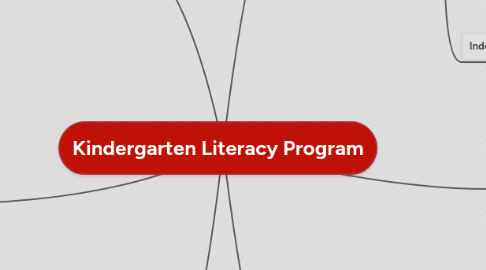
1. Phonological Awareness
1.1. Word Awareness
1.1.1. "Clapping" the syllables in words. We call syllables the "parts" of a part and we clap them out as we say them. Prin-ci-pal has three syllables or claps.
1.1.2. Recognizing rhyming words.
1.1.3. Alliteration, or words that start with the same sound. For example, great green grapes.
1.2. Phonemic Awareness
1.2.1. "Chopping" the sounds in words. Hearing and saying each sound in a word. When we practice this in kindergarten, we call it "chopping."
1.2.2. Recognizing initial and ending sounds in words. "Knock out the first sound in cat."
1.2.3. Blending sounds together
1.2.4. Adding, taking away, and substituting sounds in words. Ex: "Take away the /b/ from bat. What's left?"
2. Working with Words
2.1. Building Words
2.1.1. Letter tiles
2.1.2. Magnetic letters
2.2. Sorting Words
2.2.1. Sort by initial sound
2.2.2. Sort by ending sound
2.2.3. Sort by word family
2.2.4. Sort by number of syllables
2.3. Word Families
2.3.1. A word family is a set of words with the same ending. All of the words in the family rhyme. The 'at' word family includes 'cat, bat, rat, mat,' etc.
2.4. Simple Words
2.4.1. Students are taught CVC words. CVC stands for Consonant Vowel Consonant. For example: hen, pin, and cat, are CVC words.
2.5. Sight Words
2.5.1. Sight words are the common, high-frequency words that appear often throughout a text. Students are taught to recognize sight words so that they can become more fluent readers and writers. Some sight words are: of, the, me, to. In kindergarten we learn about 40 sight words.
3. Phonics
3.1. Alphabetic Principle: Learning that letters are the symbols to represent the speech sounds that we make when we read and speak.
3.1.1. Learning letter sounds
3.1.2. Learning letter names
4. Reading
4.1. Teacher Modeled Reading
4.1.1. Teacher uses a picture book to do a reading lesson with the whole class.
4.1.1.1. Knowledge building
4.1.1.2. Reading fluency and expression
4.1.1.3. Vocabulary
4.1.1.4. Reading comprehension strategies
4.1.1.5. Concepts of print
4.2. Shared Reading
4.2.1. Teacher uses an enlarged text with the whole class. This is usually done with "big books" or large poetry. Students help read with the teacher and a pointer is used. Usually more emphasis on concepts of print and fluency/expression.
4.2.1.1. Knowledge building
4.2.1.2. Reading fluency and expression
4.2.1.3. Vocabulary
4.2.1.4. Reading comprehension strategies
4.2.1.5. Concepts of print
4.3. Guided Reading
4.3.1. Teacher uses copies of a short text to teach reading skills to a small group of students. In kindergarten, these books are
4.3.1.1. Knowledge building
4.3.1.2. Reading fluency and expression
4.3.1.3. Vocabulary
4.3.1.4. Reading comprehension strategies
4.3.1.5. Concepts of print
4.4. Independent Reading
4.4.1. Students read by themselves. Book should be a "good fit" and should be be interesting to the child.
4.4.1.1. Concepts of print
4.4.1.2. Reading comprehension strategies
4.4.1.3. Vocabulary
4.4.1.4. Reading fluency and expression
4.4.1.5. Knowledge building
5. Writing
5.1. Teacher Modeled Writing
5.1.1. Teacher typically models writing during mini-lessons before students work independently (this is what Writer's Workshop looks like). Teacher also models writing throughout the school day for other areas of the curriculum. By modeling writing, important concepts are taught, like starting a sentence with a capital letter, adding spaced between words, sounding out words, or revising and editing a work.
5.1.1.1. Writing strategies
5.1.1.2. Craft and Conventions of Writing
5.1.1.3. Concepts of print
5.2. Shared and Interactive Writing
5.2.1. Teacher uses large chart paper and markers to create writing with large text with the whole class. Shared and interactive writing are similar in that students are sharing the pen and helping the teacher write.
5.2.1.1. Writing strategies
5.2.1.2. Craft and Conventions of Writing
5.2.1.3. Concepts of print
5.3. Guided Writing
5.3.1. This may take place during individual teacher/student conferences during Writer's Workshop. Guided reading can also take place in small groups. Teacher makes suggestions and reinforces what's been taught in mini-lessons, but the students are doing the writing.
5.3.1.1. Writing strategies
5.3.1.2. Writing craft and conventions
5.3.1.3. Writing fluency
5.3.1.4. Concepts of print
5.4. Independent Writing
5.4.1. Students write on their own and they hopefully use the ideas that the teacher shared during the mini-lesson. Most of the writing in kindergarten is free writing or free choice writing, so students can choose the topics they want to write about. Some independent writing in kindergarten is finishing a sentence prompt, like "When I grow up..."
5.4.1.1. Writing strategies
5.4.1.2. Writing craft and conventions
5.4.1.3. Writing fluency
5.4.1.4. Concepts of print
